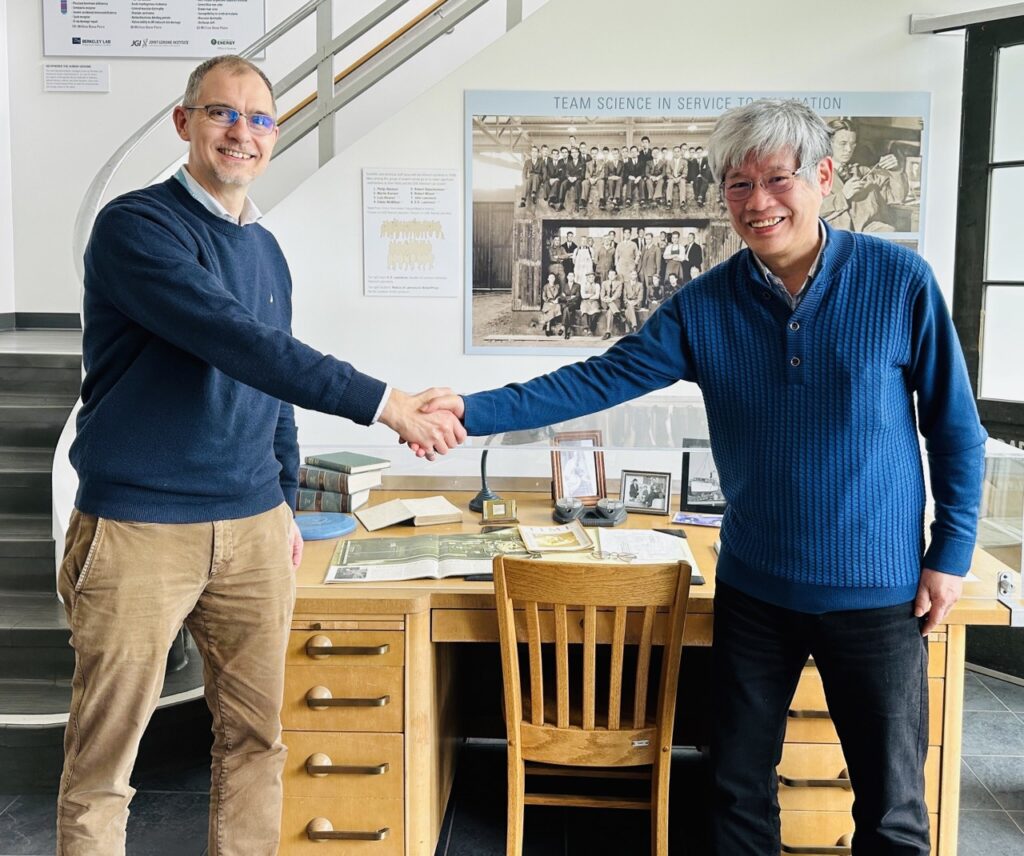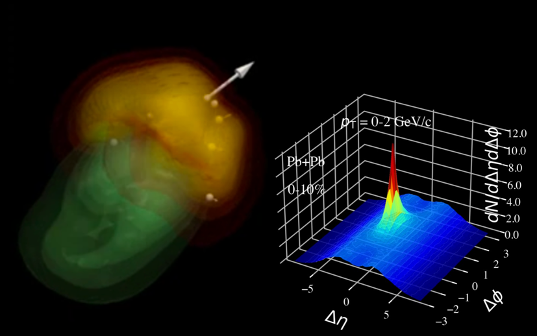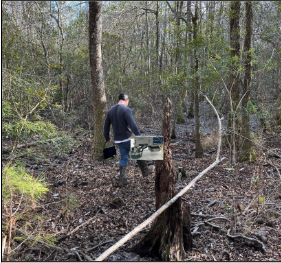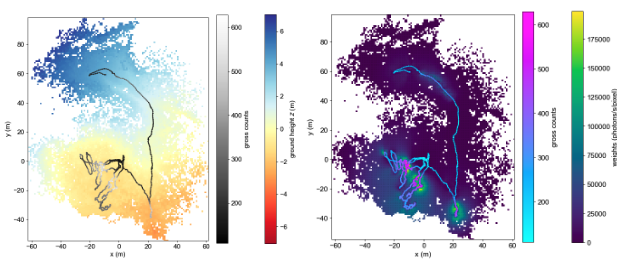In this issue:
- Director’s Corner
- A New Dimension to the Jet-induced Mach Cone in the Subatomic QGP Droplets
- Exploring Machine Learning at VENUS
- Applied Nuclear Physics Program Aiding Clean-up of Cold War-Era Radioactive Contamination through Radiological Mapping
- Inclusion, Diversity, Equity, and Accountability Moments
- Fragments
-
Director’s Corner
In March we celebrated Women’s History Month and in this context it is very fitting for Darleane C. Hoffman, a pioneering nuclear chemist, to receive the Enrico Fermi Presidential Award. We continue to celebrate and honor the contributions of all women in the Nuclear Science Division, past and present. During the past month, numerous events took place across Berkeley Lab and a special event, co-sponsored by the Nuclear Science Division, took place on the Trans Day of Visibility featuring Oxford scientist Dr. Carla Barker, an expert on thin materials.
In this issue of the NSD Newsletter we learn about exciting theoretical studies by the NSD theory group of Mach cones that are produced by jets in high-energy heavy-ion collisions and provide insights on the equation of state and shear viscosity in the quark gluon plasma. At the same time recent results from the STAR Beam Energy Scan II are demonstrating how the QGP production is “turned off” when going to lower collision energies.
We also learn about how machine learning approaches are being applied to the operations of both the VENUS ion source at the 88-Inch cyclotron and the GRETA γ-ray detector array. Gamma-ray tracking will not only advance our understanding of nuclei far from stability, as GRETA will do, but it also has important applications. For example, as described in this issue, gamma-ray mapping techniques developed by the Applied Nuclear Physics program help with the assessment and ultimately the remediation of contamination of groundwater and wetlands at the Savannah River Site. This will be an important contribution to similar efforts at other sites that deal with contamination.
Related to the Nuclear Theory Program, it is noteworthy that Berkeley Lab recently signed a new MoU with the RIKEN iTHEMS center to continue the collaboration on theoretical physics in areas of lattice QCD and other computational many-body theory, tests of fundamental symmetries using nuclei and atoms, nuclear and neutrino astrophysics; and quantum information science. We are looking forward to continuing the productive and mutually beneficial cooperation with RIKEN iTHEMS that also builds on the close connection in nuclear theory with UC Berkeley and the NSF Frontier Center Network for Neutrinos, Nuclear Astrophysics, and Symmetries (N3AS).

Tetsuo Hatsuda, Director of RIKEN iTHEMS, and Reiner Kruecken celebrating the signature of the LBNL-iTHEMS MoU. Finally, this issue also raises awareness about the important work that the Ethics Committee of the American Physical Society is doing and some of the challenges associated with addressing ethics complaints that are being raised.
Sincerely,

-
A New Dimension to the Jet-induced Mach Cone in the Subatomic QGP Droplets
Projectiles traveling at a speed greater than the velocity of sound generate Mach cones, such as the sonic boom originating from a supersonic aircraft. These kinds of Mach cones are also produced on the femtometer scale inside the droplets of quark-gluon plasma (QGP) by propagating jets in high-energy heavy-ion collisions at the Relativistic Heavy-ion Collider (RHIC) and Large Hadron Collider (LHC). Inside the subatomic droplets of QGP, energetic jet partons propagate at the velocity of light and lose energy and momentum to the medium through strong interaction. The lost energy and momentum becomes a source of sound in the medium with sound velocity only a fraction of the velocity of light. This generates a sound wave in the form of a Mach cone which will manifest itself in the final soft hadrons correlated with the energetic jets. Study of this Mach cone structure in the final soft hadron distribution can shed light on the equation of state (EoS) and shear viscosity in the QGP medium.

Figure 1: 3D energy density distribution of a jet-induced Mach cone in Pb+Pb collisions at LHC (left) and soft hadron correlation in azimuthal angle and rapidity with respect to a photon-tagged jet from theoretical simulations (right). Arrowed lines represent jet partons, red and orange color represent energy density of the Mach cone, and green color represents the negative energy density of the diffusion wake. In a recent article (Phys. Rev. Lett. 130 (2023) 5, 052301), Xin-Nian Wang from NSD’s Nuclear Theory program and his collaborators explored the 3D structure of the jet-induced Mach cone excitation in Pb+Pb collisions at LHC through theoretical simulations of the jet transport inside a hydrodynamically expanding QGP. They found that the associated diffusion wake of the Mach cone produces a unique valley structure on top of the ridge from multiple parton scattering in soft hadron correlation with respect to photon-tagged jets in azimuthal angle and rapidity. The images in Fig. 1 show a 3D energy distribution of a jet-induced Mach cone and the soft hadron correlation.
This new dimension in the soft hadron and jet correlation in the rapidity direction opens up a new window to the study of jet-induced Mach cones. The unique structure should be easy to detect and will provide additional constraints on the equation of state and transport coefficients of the quark-gluon plasma as their study shows.
-
Exploring Machine Learning at VENUS
In 2021, a collaboration of NSD scientists from the Applied Nuclear Physics, Low-Energy Nuclear Physics, and the 88” Cyclotron programs received funding through a DOE Office of Science FOA for “Data Analytics for Autonomous Optimization and Control of Accelerators and Detectors” to explore application of machine learning approaches to the operations of both the VENUS ion source [1] and the GRETA γ-ray detector array [2].
The primary goal of this project is to explore the best applications of existing machine learning approaches and techniques to optimize and automate operations of both devices. Work has primarily been focused so far on the case of VENUS. The team has established a continuous logging system that has been used to populate a time-series database with relevant control and diagnostic parameters from the operation of the source for over a year. The researchers, supported by a group of undergraduate researchers, are exploring the use of predictive neural networks and Bayesian optimization of the parameter space to tune the ion source.
By providing training data, such as the parameter values that VENUS was operating at and the corresponding beam current produced, the team has begun to develop a neural network which is intended to predict the current for other parameter values and use it to optimize the source. Early indications, however, suggest that in order to do this successfully, the range of input parameters must be extended and the researchers are therefore installing environmental sensors at the ion source in order to measure additional parameters such as temperature and air pressure.
In contrast, the use of Gaussian Process Regression (GPR) to map the parameter space and guide optimization of the VENUS tuning procedure has been very successful. Using this approach, a probability map of the full parameter space is generated from just a few measurements at different parameter values. The probabilistic map can then be used to guess parameter values which are likely to provide a better beam current. By performing the procedure a few dozen times an optimal solution is iteratively approached within a few hours, a similar timescale that would be expected from a human operator. The GPR approach has been shown to robustly produce a maximized beam current within a limited parameter space. Fig. 1 shows the result of using GPR to explore a two-dimensional parameter space during a test run with VENUS. The black circles represent measured observables, while the smooth distribution in the background shows the predictions from the GPR. Work is ongoing to extend this effort and potentially identify useful operational settings for VENUS which have not been considered by human operators.
Figure 1. Two dimensional parameter space explored in a test run. Circles represent the measured data, the smooth distribution in the background shows the predictions from Gaussian Process Regression. This project is led by Damon Todd from the Low Energy Nuclear Physics program, Marco Salathe from the Applied Nuclear Physics program and Heather Crawford, from the Low Energy Nuclear Physics program.
[1] Recent progress on the superconducting ion source VENUS, J.Y. Benitez et al., Review of Scientific Instruments 83, 02A311 (2012), DOI: 10.1063/1.3662119
[2] The GRETA Final Design Report, 2020. Available online: GRETA_FDR.pdf -
Applied Nuclear Physics Program Aiding Clean-up of Cold War-Era Radioactive Contamination through Radiological Mapping
From 1955–1988, low-level waste solutions from the processing of uranium and irradiated nuclear fuel were discharged into unlined earthen storage basins at the Savannah River Site (SRS) F-Area [1]. Over the decades, radioactive contaminants including uranium and iodine-129 (I-129) have leaked out of the basins and into the groundwater of the surrounding wetlands, and are now present at levels that exceed regulatory thresholds.

Figure 1: Hansell Gonzalez-Raymat of SRNL carries LBNL’s MiniPRISM radiation imager through the SRS F-Area wetlands. In March 2023, scientists from NSD’s Applied Nuclear Physics (ANP) program returned to the SRS F-Area wetlands to conduct handheld gamma-ray surveys in order to map the intensity and spatial distribution of radioactive contaminants in the area. Using ANP’s Scene Data Fusion (SDF) radiological mapping technology (see, e.g., [2]), roughly 0.25 km2 of dense forested wetlands were surveyed. Several uranium hotspots (up to roughly five times higher than the SRS natural background) were identified, and more detailed analysis is ongoing both to refine the mapping results and to examine possible yearly variations compared to measurements from the team’s 2022 campaign. In Fig. 1, a Savannah River National Laboratory (SRNL) scientist can be seen carrying LBNL’s MiniPRISM radiation imager through the SRS-F Area wetlands. Fig. 2 shows SDF results, including a preliminary reconstruction of low energy gamma-ray intensities during one survey. In addition to the SDF mapping systems that are sensitive to uranium radioactivity, LBNL is exploring whether silicon drift detectors are a viable technology to map the I-129 in situ. These efforts are part of the larger DOE-EM ALTEMIS project, which aims to develop long-term remediation and monitoring strategies for contaminated DOE legacy sites and have used the F-Area wetlands as a test bed.

Figure 2: Left: ground height estimation of a mapped area at the SRS F-Area. Right: preliminary reconstruction of low-energy gamma-ray intensities during a single survey. Hotspots are visible in the seepage areas towards the bottom of the map and are clearly distinguishable from low-activity areas. Jayson Vavrek, Brian Quiter and Joanna Szornel collected the data in March 2023 with support from the Savannah River Site. Carol Eddy-Dilek (SRNL) and Haruko Murakami-Wainwright (MIT/LBNL) are Lead and Co-Lead of the DOE ALTEMIS project supporting this work. Zexuan Xu (LBNL EESA) is the LBNL PI.
[1] Biogeochemical gradients as a framework for understanding waste‐site evolution, M. Denham and K. Vangelas, Remediation Journal: The Journal of Environmental Cleanup Costs, Technologies & Techniques 19.1 (2008), DOI: 10.1002/rem.20188
[2] Free-moving quantitative gamma-ray imaging, D. Hellfeld et al., Scientific Reports 11 (2021), DOI: 10.1038/s41598-021-99588-z -
Inclusion, Diversity, Equity and Accountability Moments

APS Ethics Committee
In 2019, the American Physical Society (APS) formed an Ethics Committee (EC), charged to provide guidance on how the APS can promote ethical behavior by members, and police unethical behavior, including scientific ethics (fabrication, falsification or plagiarism) and interpersonal misbehavior – sexual harassment or bullying, for example. EC member and NSD Senior Scientist Spencer Klein discussed EC activities at a recent NSD staff meeting and summarizes those activities here.
Under the guidance of the APS Board, the committee works in several areas. They review APS statements on ethics and propose new ones, as appropriate. They provide ethics education, through presentations and workshops at APS meetings, and articles in different publications, such as Physics Today.
The EC develops policies and procedures for the APS to handle reports of misconduct. There are two categories: incidents at APS meetings, and everything else. For incidents at APS meetings, the APS will immediately (i.e., during the meeting) investigate and react as appropriate, and can remove the perpetrator from the meeting if needed.
Other complaints are dealt with in a longer, more involved process, starting with an initial review by the APS Ombudsperson (an outside lawyer), review by the EC, and then by the APS Board. Appeals are also possible. The APS also asks nominators (and, later, nominees) if nominees for APS committees, offices, prizes or fellowships are known to have committed misconduct. Positive answers are followed up and action may be taken.
For non-meeting complaints, the APS will not investigate, but will react to complaints which include an investigatory report by other agencies, such as the employer or other agency. The non-investigation policy can be problematic, since investigatory reports are usually private, and not available to would-be complainants or the APS.
Although many people think that the APS should conduct investigations when needed, there are real challenges in doing so. It would require significant resources, and could open the door to lawsuits. Incidents reported to the APS will likely have previously been investigated by one or more groups. Witnesses (especially victims of sexual harassment) may not want to tell their story many times, and not everyone will trust or cooperate with a U. S.-based organization. There is also some risk that different investigations reach different conclusions.
But, with outside investigatory reports generally unavailable, without its own investigation, the APS may be unable to act, even against pervasive behavior. And that is clearly extremely awkward. The EC is continuing to grapple with this.
Recent DEI topics @ NSD Staff Meetings
January 10, 2023 – Update on the Mental Health Initiative and WD&E Deadlines
January 24, 2023 – Effective Teams
February 7, 2023 – APS Ethics Committee
February 21, 2023 – Outreach Opportunities
March 7, 2023 – K-12 Stem Programs
March 21, 2023 – Women’s History Month and Transgender Day of Visibility
April 4, 2023 – Inclusion and Equity in Science PublicationsLuminary Cards

To recognize their efforts in the area(s) of Inclusion, Diversity, Equity, and Accountability, the following people received a Luminary Card:
Spencer Klein
-
Fragments
In February, the final results from the MAJORANA DEMONSTRATOR were published in Physical Review Letters. The results set a limit on the half-life of the neutrinoless double beta decay of Ge-76.
NSD Senior Scientist Volker Koch has been named as an Outstanding Referee by the Physical Review journals, as chosen by the journal editors for 2023. Instituted in 2008, the Outstanding Referee program recognizes the number, quality, and timeliness of referee reports and honors a small fraction of the journal’s 82,000 referees each year.
NSD Postdoctoral Researcher Weronika Wolszczak has been selected as the co-chair of the Berkeley postdoc association.
NSD welcomes new hires Adan Esparza (Research Associate), Lei Pan (Postdoctoral Researcher), Kushant Patel (Senior Scientific Research Associate), Celine Li (Senior Scientific Engineering Associate), Michael Gorin (Administrative Assistant), Ryan Heller (Research Scientist), and Dayle Silverio (Administrative Assistant).
Several NSD employees were recently promoted. Mark Bandstra, Alexey Drobizhev, Yue Shi Lai, Marco Salathe, and Jayson Vavrek were all promoted to Research Scientist.
Service awards
- Mateusz Ploskon has reached the milestone of 15 years of service.
- Shamsu Basunia has reached the milestone of 20 years of service.
- Alan Poon has reached the milestone of 25 years of service.
- Xin-Nian Wang has reached the milestone of 30 years of service.
Congratulations to all of you for your achievements!
-
Sign up for our newsletter!